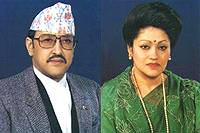NEPALI CULTURE
Nepal is one of the founding members of South Asian Association for Regional Cooperation (SAARC) which was formed in December 1985. The SAARC Secretariat was set up in Kathmandu in January 1987 and later in the same year in November, third SAARC summit was held in Kathmandu.
 Late King Birendra Bir Bikram Shah Dev ruled Nepal for 30 years from January 30, 1971 to June 1, 2001. His son Crown Prince Dipendra was named King on June 2, 2001, after the unfaithful Royal family massacre of June 1, 2001 that took the lives of the King, Queen, Prince, Princess and five other Royal family members. But King Dipendra soon died in hospital on June 4, 2001. The
Late King Birendra Bir Bikram Shah Dev ruled Nepal for 30 years from January 30, 1971 to June 1, 2001. His son Crown Prince Dipendra was named King on June 2, 2001, after the unfaithful Royal family massacre of June 1, 2001 that took the lives of the King, Queen, Prince, Princess and five other Royal family members. But King Dipendra soon died in hospital on June 4, 2001. The
younger brother of late King Birendra, His Majesty King Gyanendra Bir Bikram Shah Dev was accessioned to throne on June 4, 2001 and currently rules the country. He is the twelfth King in the Shah dynasty.
During a regular gathering at Narayanhity Royal Palace on the Friday night of June 1, 2001, the gathered Royal family members were shot dead and some were injured within a few minutes of time by Crown Prince Dipendra, who was heavily under the influence of alcohol and drugs. Crown Prince Dipendra also shot himself in an attempt of suicide over an argument he had with his parents about the woman he wanted to marry. Crown Prince Dipendra was admitted to hospital in a coma and critically wounded condition, but still was named the King.
The King in Nepal is seen as a Living God, the reincarnation of Lord Vishnu. Late King Birendra was very popular and deeply loved by the people of Nepal who were greatly shocked and saddened by the news and it took quite a long time for the countrymen to come out from their self mourning.
During a regular gathering at Narayanhity Royal Palace on the Friday night of June 1, 2001, the gathered Royal family members were shot dead and some were injured within a few minutes of time by Crown Prince Dipendra, who was heavily under the influence of alcohol and drugs. Crown Prince Dipendra also shot himself in an attempt of suicide over an argument he had with his parents about the woman he wanted to marry. Crown Prince Dipendra was admitted to hospital in a coma and critically wounded condition, but still was named the King.
The King in Nepal is seen as a Living God, the reincarnation of Lord Vishnu. Late King Birendra was very popular and deeply loved by the people of Nepal who were greatly shocked and saddened by the news and it took quite a long time for the countrymen to come out from their self mourning.
The King, Queen and other members of the Royal family were carried to Pashupati Aryaghat, next to the Holy Bagmati River, for their last rites. Desperate to know the truth, people blocked traffic in protest and riots began in the streets of Kathmandu and even curfew had to be imposed to disperse the restless crowd which just could not believe what had happened inside the highly guarded Royal Palace.
People shaved their heads as a sign of respect for their beloved King as they would have done in the demise of their family members as per Hinduism and a 5 day closure of government offices and 13 days of official mourning was announced. Just after 48 hours of the title “King”, King Dipendra died in the hospital and the younger brother of late King Birendra, Prince Gyanendra became the new King of Nepal - three Kings in 4 days.
The murder of Royals inside Narayanhity Royal Palace is said to be the second worst mass killing of royalty in the world after the Romanovs, who were killed back in 1918 during the Russian civil war.

No comments:
Post a Comment